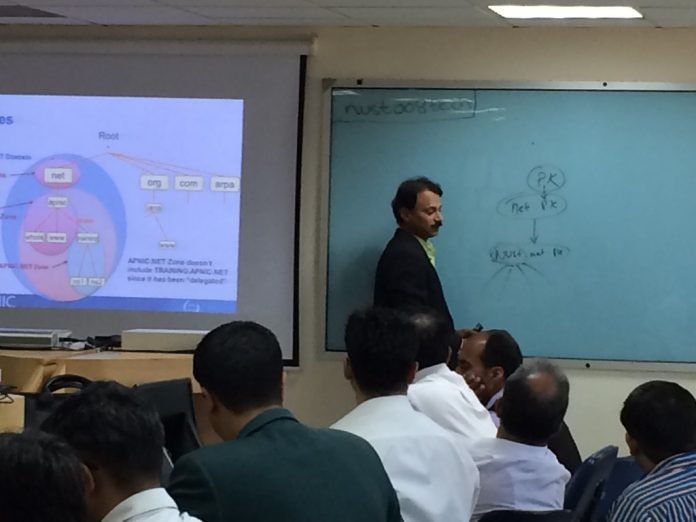Last Updated on March 4, 2024 by Nasir Hanif
Table of Contents
Introduction
In conclusion, cyber security training is an essential component of a company’s risk management strategy. It helps to ensure that employees are aware of the risks associated with online activities and can respond appropriately in the event of a breach. Companies should invest in regular and comprehensive cyber security training to protect themselves from potential threats.
Definition of Cyber Security Training
Cyber security training is the process of educating staff and users about computer security best practices, in order to protect networks and data from malicious attacks. It is an important part of any organization’s security strategy as it helps ensure that all personnel understand the risks of cyber threats and know how to protect against them. The best cyber attack course will provide the knowledge and tools to prevent a cyber attack, determine its origin, and take the necessary steps to mitigate damage.
Cybersecurity training can come in many forms, from interactive educational programs to seminars and workshops. In some cases, organizations may even hire external experts to provide specialized training for their staff members. The goal of such programs is usually to equip users with the knowledge they need to recognize potential threats, avoid risky behaviours online, and respond promptly in the event of a breach or attack.
The most effective cyber security training typically covers topics such as email safety protocols, password protection best practices, secure communication techniques (e.g., encryption), social engineering tactics used by attackers (e.g., phishing), malware prevention strategies (e.g., patching systems regularly), physical access control measures (e.g., locking doors), network monitoring tools (e.g., firewalls), wireless network protection protocols (e.g., WPA2/WiFi Protected Access II)and other relevant topics related to data privacy and information protection.
Benefits of Training
Training is essential for businesses that want to ensure their employees are productive and successful. It helps them to become better at what they do, enabling them to work more efficiently and effectively. Training can also benefit the organisation in numerous ways, from improving customer service to reducing employee turnover. Here are just some of the many benefits of training:
1. Improved Productivity: Training helps employees become better equipped with the skills needed for their job role, increasing their productivity and efficiency in completing tasks. This can result in increased output and improved quality of work, leading to a stronger bottom line for the company.
2. Increased Customer Satisfaction: Well-trained staff have greater knowledge about products or services offered by a company, enabling them to provide better customer service and support when interacting with customers. This leads to an increase in customer satisfaction levels which can help boost sales revenue as well as create loyal customers who return time and again due to excellent service standards provided by trained staff members.
3. Increased Employee Morale: When employees feel valued through training opportunities it boosts morale within a workplace creating an environment where everyone feels appreciated for their efforts regardless of seniority or experience level within the organisation. Staff members also gain confidence knowing that they’re up to bugs.
Who Needs Cyber Security Training
Cyber security is an increasingly important issue in today’s digital world, with cyber-attacks becoming more frequent and sophisticated. As a result, it is essential for organizations and individuals to have the right cyber security training in order to protect their data, systems and networks from malicious activities. But who exactly needs this type of training?
At the most basic level, anyone who uses the internet should have some form of cybersecurity training. This includes employees in businesses or organizations as well as home users. Cyberattacks can target any person or organization regardless of size or industry; therefore it is important for everyone to be aware of how to best protect themselves online.
Organizations should also ensure that their staff are adequately trained in cyber security practices and procedures. Cybersecurity threats vary depending on the industry so it is important for companies to provide tailored courses that are specific to their sector and any risks associated with it. For example, financial institutions may need more comprehensive knowledge about malware prevention than retail businesses do, due to the sensitive nature of customer data they possess.
Individuals can take proactive measures by enrolling in online courses which cover topics such as phishing scam detection, password management techniques and secure browsing habits among other things. This will help them stay up-to-date about bugs.
Employees and Managers
As the workforce continues to evolve, so too do the relationships between employees and managers. In today’s business world, this relationship is more important than ever. Employees and managers must be able to work together effectively in order to ensure that a company runs smoothly and meets its goals.
The key to an efficient working relationship between employees and managers is communication. Employees should feel comfortable voicing their opinions, asking questions, and providing feedback in order for there to be an honest exchange of ideas. This can help managers understand how their staff members think about certain issues, which can lead to more creative solutions for the team. On the other hand, managers must also create an open environment where employees know that they will be heard without fear of repercussions or judgement.
It is also important for both sides to respect each other’s roles within the organization. Managers are responsible for setting goals and expectations while employees are responsible for meeting those expectations through their work efforts. When both parties respect each other’s roles it will make it easier for them to collaborate on projects without tension or misunderstandings arising from unclear instructions or objectives given by either side.
In addition, trust is essential when it comes to creating successful working relationships between employees and managers in any organization. Managers
IT Professionals
The world of Information Technology (IT) is ever-changing and complex, making it a challenging and rewarding career choice. IT professionals are responsible for managing the systems, networks, databases, and software that power modern businesses. They must stay up to date on the latest technology trends to ensure their employers have access to cutting-edge solutions that meet their needs.
IT professionals have a variety of job roles which involve designing, developing, implementing and maintaining computer systems in order to help companies reach their goals. They perform tasks like troubleshooting hardware or software problems; setting up networks; programming applications; providing technical support; designing websites; creating databases; analyzing data; monitoring performance metrics and more. Additionally, they must ensure security protocols are followed in order to protect sensitive information from cyber attacks or other malicious activities.
It is essential for IT professionals to possess strong problem-solving skills in order to identify issues quickly and provide effective solutions. They must also be organized with excellent communication skills in order to effectively interact with colleagues from different departments or clients from external organizations. Furthermore, they should be comfortable working independently as well as collaboratively within teams since many projects require input from multiple stakeholders throughout the business environment.
Types of Cyber Security Training
Cyber security training is essential for businesses and organizations of all sizes in order to protect their data, networks, and systems. Cyber security threats are increasing in frequency and sophistication, making it critical to ensure the appropriate personnel are equipped with the necessary knowledge to identify and respond to attacks.
There are several types of cyber security training available that can help an organization reduce its risk profile while protecting confidential information from malicious actors. The following outlines four types of cybersecurity training that businesses should consider:
1. Basic Cyber Security Training: This type of training focuses on providing employees with a basic understanding of how cyber threats work, as well as how they can protect against them. It covers topics such as password management, phishing scams, malware protection, data encryption techniques, firewalls and other forms of network protection. This type of training is typically offered in-house or through online webinars or courses.
2. Advanced Cyber Security Training: Advanced cyber security courses provide more specialized instruction on topics such as penetration testing and vulnerability assessment techniques. These courses often focus on hands-on learning activities that allow participants to gain practical experience in applying various tools used by hackers in order to identify weaknesses within an organization’s network or system architecture before attempting an attack against
Online Courses and Seminars
In recent years, online courses and seminars have become increasingly popular for those looking to further their education or advance their career. With the convenience of attending these classes from home and the cost savings associated with them, more people are taking advantage of this option.
Online courses and seminars offer an alternative to traditional classroom-based learning. They provide participants with a flexible way to learn at their own pace, without having to travel or take time off from work. Participants can access course materials such as video lectures, readings, quizzes and assignments through their computer or mobile device. This allows them to learn in the comfort of their own home or wherever is most convenient for them.
Another benefit of online courses is that they often cost much less than traditional classes offered on college campuses. Many providers also allow participants to pay a one-time fee which gives them lifetime access to all course materials and resources, meaning they can revisit lessons as many times as needed until they have mastered the material. Additionally, many online courses offer certificates upon completion which may count towards professional development hours in certain fields like teaching or healthcare administration.
Online courses vary greatly in terms of topics covered and intensity level; some are designed for beginners while others are geared towards more advanced learners looking for specialized knowledge
In-Person Workshops and Conferences
In-person workshops and conferences are powerful learning experiences that have been around for centuries. They offer a unique opportunity to connect with others in the same field and learn from experts in person. Whether it’s a local event or one held on the other side of the world, attending an in-person workshop or conference can be a great way to broaden your knowledge and make valuable connections.
The benefits of attending an in-person workshop or conference are numerous. One of the main advantages is being able to interact directly with speakers and attendees, allowing you to ask questions, get feedback, and network with like-minded people. You can also gain insight into cutting-edge research that may not yet be available online or in books—gaining access to this type of information can give you a competitive advantage over those who don’t attend these events. Additionally, many workshops and conferences include opportunities for hands-on activities such as labs, which will help you develop new skills quickly.
When planning on attending an event like this, there are several things you should consider doing beforehand. First off, make sure you do your research so that you know what topics will be covered at the event; this way you won’t waste time listening to presentations about topics.
Elements of Effective Cyber Security Training Programs
Cybersecurity is an ever-evolving field, and the need for a comprehensive training program is more important than ever. As businesses become increasingly reliant on technology, it’s essential to ensure employees are well-versed in cyber security practices to protect their systems from malicious actors. The following are some key elements of an effective cybersecurity training program:
1. Comprehensive Course Content: A comprehensive course should cover the fundamentals of cyber security, such as basic risk assessments, password management best practices, and social engineering tactics. It should also include more advanced concepts like malware analysis, network monitoring tools and techniques for detecting malicious activity.
2. Interactive Learning: Cybersecurity is a complex subject that can often be difficult to absorb through reading or lectures alone. To ensure employees understand the concepts presented in the training course, it’s important to supplement traditional learning methods with interactive activities such as quizzes and simulations that allow users to practice what they learn in a safe environment without putting their systems at risk of attack.
3. Hands-on Experience: While lectures on theory are essential for understanding how cybersecurity works on paper, there’s no substitution for hands-on experience when it comes to mastering the skills necessary to defend against real threats.
Understanding the Basics of Cybersecurity
Cybersecurity is an ever-increasing concern for individuals and businesses alike. With the advancement of technology, the potential for cybercrime has grown exponentially. To protect yourself from such threats, it’s important to have a basic understanding of what cybersecurity is and how it works.
At its core, cybersecurity is the practice of protecting networks, systems, and programs from digital attacks. This includes everything from viruses to hackers attempting to access sensitive information or disrupt operations. Cybersecurity also covers measures taken to prevent malicious activities like identity theft or fraud.
To ensure your data remains safe and secure, there are several things you can do:
1) Utilize strong passwords – Passwords are the first line of defence against cyber attackers so it’s important that they remain secure at all times. Use a combination of letters (upper and lowercase), numbers, and symbols when creating passwords that are at least 8 characters long in order to make them difficult for attackers to guess or crack with brute force tools.
2) Install anti-virus software – Anti-virus software helps protect your computer against malicious software such as viruses by scanning files regularly for any signs of infection before running them on your system. Make sure you keep your
Risk Assessment and Management Strategies are essential tools for any organization in order to reduce the potential for harm or loss. Risk assessment and management strategies can be used to identify, assess, and control the risks associated with a particular activity or operation. These strategies involve assessing the probability of an event occurring, determining what measures should be taken to mitigate any potential losses, and developing plans to manage the risk if it does materialize.
Risk Assessment & Management Strategies
The first step in developing a risk assessment is identifying all potential risks associated with an activity or operation. This includes analyzing past events that may have caused harm or losses as well as looking at current trends that could lead to future problems. Once all of these risks have been identified, they must then be evaluated according to their likelihood of occurrence and severity of impact on your organization’s operations.
Once all risks have been identified and evaluated, it is time to develop strategies for mitigating them. This involves taking proactive measures such as implementing safety protocols, establishing emergency response plans, training staff on proper handling procedures for hazardous materials, etc., in order to reduce the chances that an incident will occur or lessen its severity if it does happen.
After these proactive steps have been taken care of it is important for organizations to also create contingency
- Networking, Firewall, & System Configuration
- Identifying Potential Threats & Vulnerabilities
- Cloud Computing, Mobile Devices, & Social Media Security
- Implementing Policies to Ensure Compliance
- Data Encryption Techniques to Protect Information
- Developing an Action Plan for Addressing a Breach
A. Networking, Firewall, & System Configuration
Network configuration is an essential component of information security which includes setting up routers and firewalls to protect against malicious activities. Routers provide a physical barrier between the internal and external networks, while firewalls control the traffic that is allowed through the network. System configuration involves setting up user accounts, access controls, file permissions, application settings and other parameters to ensure that only authorized users have access to the system resources.
B. Identifying Potential Threats & Vulnerabilities
Identifying potential threats and vulnerabilities of a system is important in order to be able to protect it from attack or manipulation. Common threats include malware such as viruses and worms, malicious insiders who gain unauthorized access to systems or data, denial-of-service attacks which can shut down a computer network or website temporarily by flooding it with requests for service, phishing scams which use deceptive emails or websites in order to gain sensitive information from unsuspecting victims and social engineering where attackers take advantage of human psychology in order to manipulate people into revealing confidential data or providing them with physical access privileges they should not have. It is also important to identify vulnerable areas within a system such as weak passwords or outdated software versions so that appropriate measures can be taken in order
Apart from that, if you are interested to know about How Cyber Security Should Be the Priority then visit our Technology category.






















